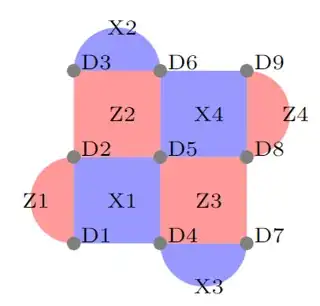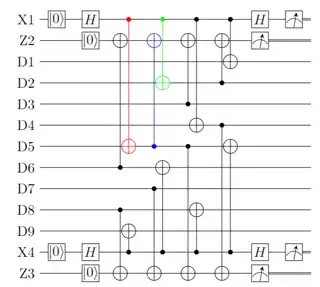I am going over this paper by Lao, and I am trying to understand how they count the two-qubit errors that induce logical errors.
I am looking at the middle-type injection, which looks like this:
Now, they count which two-qubit errors change the logical operators. I understand I can do it by one of two methods:
- The first is by propagating each possible error to the beginning of the circuit and checking whether it changes the value of the logical operators at that point. For example, $\color{blue}{X_c X_t}$ error on the blue CNOT will propagate to be an $X_5$ error, which changes the injected qubit state.
- The second is propagating the error to the end of the circuit and checking whether it will be detected on the next cycle. Here, the $\color{blue}{X_c X_t}$ error will propagate to flip both $Z_2$ and $Z_3$ stabilizers and also $X$ error on D5. This will not be corrected on the next circuit because no stabilizers will be flipped.
I tried to do it for some errors and failed to understand, for example, the error $\color{red} {I_c Z_t}$ on the red gate which they do not count as an undetectable logical error:
- when propagated to the start it becomes $Z$ error on D5 and flips stabilizer X1. Why is this not changing the value of the logical operator? Or maybe it is detected and discarded? If so, how is it detected, considering X1 is not deterministic?
- when propagated to the end, it becomes $Z$ error on D5, and flips X4. Since X4 is not deterministic and it is the first time we measure it, how can we detect it?
Is there a way to think about it that does not demand going over all the possible two-qubit errors? Is there a way to see why all the black CNOT won't create any logical error without going over all of their errors one by one?

